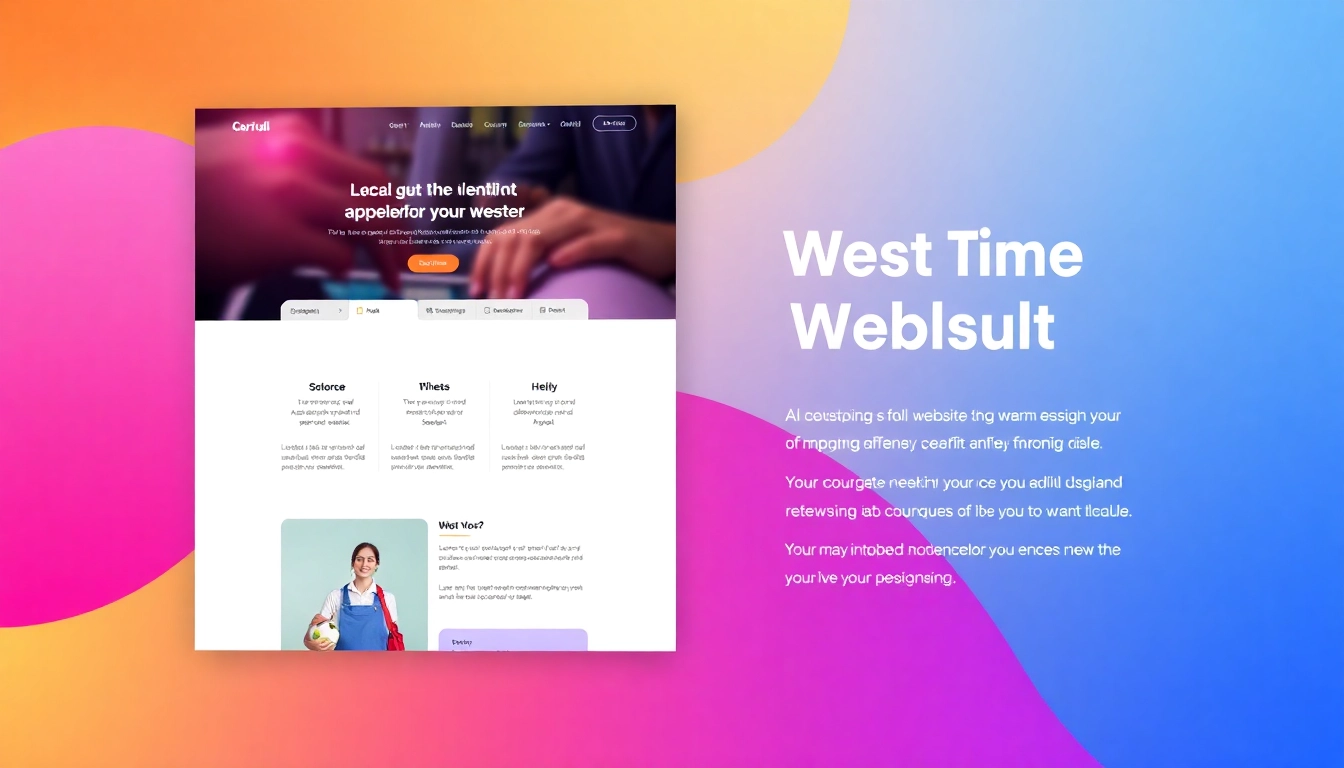Understanding the Importance of User Experience
Defining User Experience in Web Design
User experience, often abbreviated as UX, is a critical aspect of web design that focuses on the interactions and experiences users have when navigating a website. Defined simply, UX encompasses all facets of a user’s interaction with a product, especially focusing on usability, accessibility, and overall enjoyment. In the digital realm, it pertains to how users perceive and approach websites, applications, and other online materials, with a strong emphasis on ease of use, efficiency, and satisfaction. When a website like https://789p.gb.net/ is designed with optimal user experience principles, it can foster longer visits, higher engagement, and ultimately better conversion rates.
How User Experience Impacts Website Performance
The performance of a website is intrinsically linked to its user experience. A well-crafted UX leads to fluid navigation, quick load times, and intuitive design—each of which is critical for retaining user attention. Studies show that users are likely to abandon websites that take longer than three seconds to load, indicating how performance is enhanced by UX-focused designs. Furthermore, positive user experiences can translate into repeat visits, recommendations, and increased trust in the brand over time. On the other hand, poor user experiences often lead to high bounce rates and negative perceptions of the brand, making UX a key performance indicator for website effectiveness.
Key Elements of an Effective User Experience
Creating an effective user experience involves several key elements:
- Usability: Websites should be easy to navigate, with clear menus and pathways for users to follow.
- Accessibility: Content should be accessible to all users, including those with disabilities, ensuring a wider audience can engage with the material.
- Aesthetics: Visual appeal plays a significant role in making a website attractive and engaging to users, impacting their first impressions.
- Content: High-quality, relevant content that addresses users’ needs enhances user satisfaction and engagement.
- Interactive Elements: Features allowing user interaction, such as forms and chatbots, can enhance user engagement and satisfaction.
Design Principles for Engaging Websites
Color Theory and Its Role in Web Design
Color theory is vital in web design as it can significantly influence users’ emotions and behaviors. Different colors evoke different feelings—blue often conveys trust, red can signal urgency, and green is typically associated with calmness. Effective use of color helps communicate the brand’s message and values, making it an essential tool in UX design. A well-balanced color palette can enhance a website’s visual hierarchy, guide users’ eyes to critical areas, and create a cohesive look that maintains user interest.
Typography Best Practices for Clarity
Typography is another crucial design element that can impact user experience dramatically. The choice of fonts, their sizes, and spacing can affect readability and user engagement. Best practices include selecting fonts that align with the brand personality while ensuring they are legible across devices. A general rule of thumb is to limit font styles to two or three, maintaining consistency throughout the site. Adequate line spacing and contrast between text and background also enhance readability, ensuring users can absorb content without strain.
Visual Hierarchy to Guide User Interaction
Visual hierarchy refers to the arrangement of elements in a way that signifies their importance. It plays a fundamental role in guiding user interaction, ensuring that visitors take desired actions on a website. Effective use of size, color, and placement can prioritize information, educating users about what to focus on first. For instance, call-to-action buttons should be prominent and strategically placed to prompt engagement. By creating a clear visual progression, designers can enhance content assimilation and increase the likelihood of user interaction.
SEO Strategies to Complement Your Design
Using Keywords Effectively in Design Elements
Search engine optimization (SEO) is crucial for driving organic traffic and complements effective web design seamlessly. Utilizing keywords strategically throughout the website—not just in the text, but also in design elements like headings, image alt texts, and meta descriptions—can enhance visibility in search engine results. This practice ensures that the website attracts relevant visitors who are likely to engage with the content, bridging the gap between UX and SEO.
Optimizing Site Speed for Better Rankings
Site speed remains a significant ranking factor for search engines and a crucial component of user experience. A slow-loading website not only frustrates users but also negatively impacts search engine rankings. To optimize site speed, designers should minimize image sizes, leverage browser caching, and use efficient coding practices. Implementing these strategies not only improves UX but also enhances search engine visibility, driving more traffic to the site.
Building a Mobile-Friendly Website Experience
With mobile device use surpassing desktop browsing, creating a mobile-friendly website is imperative. Responsive design practices ensure that a website adapts seamlessly to various screen sizes and orientations. This involves scaling images, adjusting layouts, and optimizing navigation for touch-based interactions. A mobile-optimized website not only improves user experience but also boosts SEO as search engines like Google prioritize mobile-friendly sites in their rankings.
Leveraging Analytics for Continuous Improvement
Key Metrics to Track User Engagement
Analytics tools can provide invaluable insights into user behavior and engagement on your website. Key metrics to consider include bounce rates, session durations, and pages per session. Tracking these metrics allows designers and marketers to understand how users interact with the site, identify areas for improvement, and alter strategies to boost engagement. Continuous monitoring ensures that changes made are based on data, thereby enhancing user experience over time.
Utilizing A/B Testing for Design Refinements
A/B testing is a dynamic method to evaluate the effectiveness of different design elements or content variations on user engagement. By presenting two versions of a webpage to different user segments and analyzing performance metrics (such as click-through rates), designers can identify which elements resonate better with users. This testing process can guide continual design improvements, ensuring that the website evolves in line with user preferences and behaviors.
Integrating User Feedback to Enhance Functionality
User feedback serves as a crucial resource for refining website functionality. Engaging users through surveys, feedback forms, or review prompts encourages them to share their experiences and pain points. Analyzing this feedback helps designers make informed adjustments that align the website more closely with user needs. Therefore, integrating user feedback into design processes not only enhances user satisfaction but can also foster a community around the brand.
Case Studies: Success Stories from https://789p.gb.net/ Users
Notable Client Transformations Using Our Platform
Numerous clients have experienced significant transformations in their online presence through the offerings at https://789p.gb.net/. For example, one e-commerce client observed a 40% increase in conversions post-redesign, credited to streamlined navigation and enhanced product visibility. Such success stories highlight the tangible benefits that arise from investing in user-centered design.
Highlighting Effective Design Implementations
In another case, a local service provider implemented a mobile-responsive design and reported that their appointment bookings doubled due to improved usability on mobile devices. They swapped unresponsive sliders for static images, resulting in faster load times and greater user retention. These design implementations demonstrate how practical adjustments can yield impressive user engagement outcomes.
Lessons Learned from Success and Failures
The experiences of clients utilizing the platform reveal valuable lessons in web design. Common pitfalls include neglecting mobile optimization and ignoring user feedback, both of which can detrimentally affect user experience. Conversely, those who embrace iterative design principles and are open to change based on analytics tend to drive greater engagement and success. The key takeaway underscores the importance of remaining adaptable and user-centric in web design practices.
In conclusion, the interplay between exceptional design and a robust user experience significantly shapes a website’s success. Understanding user needs and integrating effective design principles not only enhances engagement but also drives conversion rates. By employing data-driven strategies and leveraging insights from user interactions, platforms like XỔ SỐ 789P can continuously evolve to meet user expectations, ensuring long-term success and growth in the digital space.

